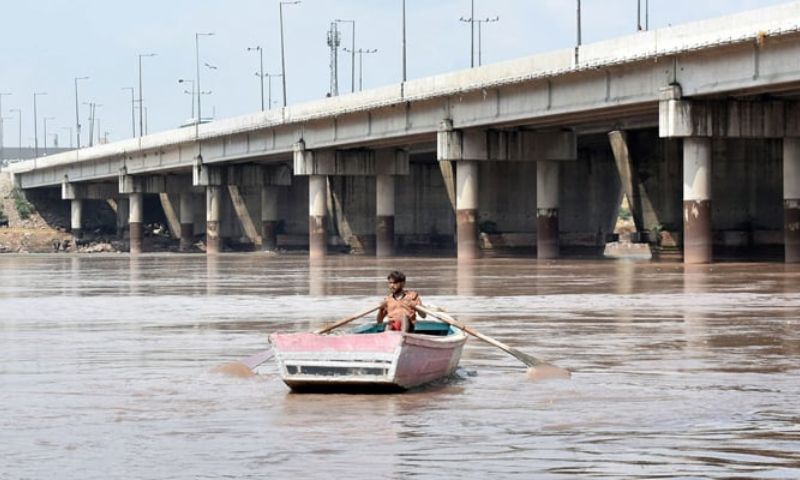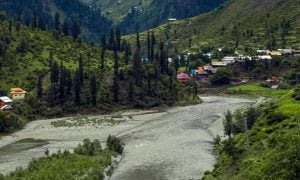ISLAMABAD: Pakistan on Tuesday issued a high flood alert after India released more water into the Sutlej and Ravi rivers, raising water levels in the eastern districts of Punjab province as heavy monsoon rains continue to lash the country.
The National Disaster Management Authority (NDMA) said on Tuesday that it was closely monitoring the situation after New Delhi informed Islamabad of water discharges from the Madhopur Dam.
Officials said India’s release had already triggered high flooding in several areas of the eastern districts of Punjab, inundating villages and farmland.
According to the NDMA, a very high flood has been reported at the Ganda Singh Wala point on the Sutlej River, where water flow has reached 195,000 cusecs.
The Ravi River at Jassar is experiencing medium-level flooding, with 88,000 cusecs recorded. Water levels are also rising at Shahdara near Lahore.
In Narowal, 56 farm workers trapped near the Ravi River were rescued. Authorities in Bahawalnagar said more than 89,000 people had been relocated to safer areas, while over 14,000 residents were evacuated from Kasur district.
Floodwaters submerge various districts
Punjab Chief Minister Maryam Nawaz has directed local administrations to speed up evacuations from flood-prone villages.
Floodwaters have already submerged residential areas and hundreds of acres of farmland in Uch Sharif, Arifwala and Pakpattan.
The Provincial Disaster Management Authority (PDMA) warned that 22 villages in Tehsil Phalia are at risk and urged residents to move to higher ground.
Relief camps and arrangements for displaced families and livestock have been set up in affected districts.
The NDMA said floodwaters released by India into the Ravi River have entered Pakistani territory, leading to a sudden surge at Jassar.
Flood level at rivers
Meanwhile, the weather department warned of heavy rainfall in India’s Himachal Pradesh, Uttarakhand, Punjab and occupied Jammu and Kashmir, which could further swell rivers flowing into Pakistan.
According to the Flood Forecasting Division, the Sutlej has entered an extremely high flood stage at some locations, while the Ravi is facing medium flooding.
The Indus River is experiencing medium floods at Sukkur and low flooding at Kalabagh, Chashma, Guddu and Kotri barrages. The Chenab has entered a low flood at Head Marala, while its tributaries are also witnessing rising levels.
Reservoirs are filling up rapidly, with Tarbela Dam almost at full capacity and Mangla Dam nearing maximum levels. Smaller dams, including Khanpur, Rawal and Simly, are also recording increased inflows.
More rains forecast
The Pakistan Meteorological Department (PMD) forecast further widespread rains, wind and thundershowers in northeast Punjab and Azad Kashmir during Tuesday night and Wednesday, with heavy falls expected in some areas.
The weather department warned of landslides and mudslides in Azad Kashmir’s hilly areas, urban flooding in cities such as Lahore, Gujranwala and Sialkot, and damage to weak structures from windstorms and lightning.
Monsoon rains devastation
Monsoon rains and flash floods have caused widespread destruction across Pakistan since June. In Khyber Pakhtunkhwa province alone, at least 406 people have been killed and 245 injured, according to a PDMA report.
Among the dead are 167 women and 108 children. Thousands of houses have been damaged, nearly 6,000 livestock lost, and dozens of schools destroyed. Nationwide, more than 800 people have died since late June, the NDMA said.
Meanwhile, at least 65 people have been killed in Indian Illegally Occupied Jammu and Kashmir. Officials in Delhi said many rivers and streams in the Himalayan region remain swollen, with homes, roads and bridges damaged.
This week’s alert marks rare direct communication between India and Pakistan, after New Delhi suspended the decades-old Indus Waters Treaty in April.
Indian officials conveyed the flood warning to Islamabad through diplomatic channels rather than through the IWT’s permanent commission. Pakistan has rejected India’s suspension of the treaty, calling it a violation of international law.
Heavy monsoon rains, intensified by climate change, have raised fears of a repeat of Pakistan’s catastrophic 2022 floods, which inundated a third of the country and killed more than 1,700 people.
The NDMA has urged the public to stay away from rivers, avoid unnecessary travel, and follow official alerts.

























